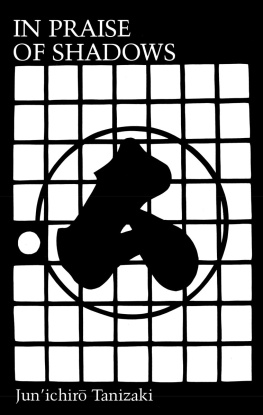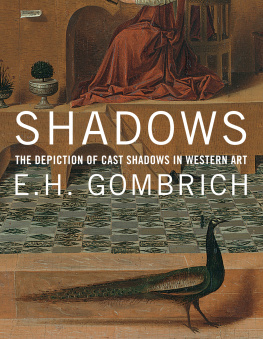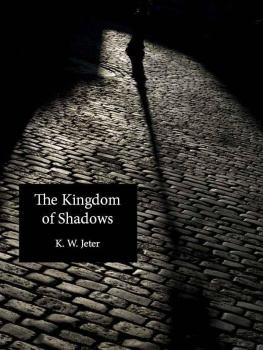Junichiro Tanizak - In Praise of Shadows in Praise of Shadows
Here you can read online Junichiro Tanizak - In Praise of Shadows in Praise of Shadows full text of the book (entire story) in english for free. Download pdf and epub, get meaning, cover and reviews about this ebook. year: 1980, publisher: Independent Pub Group, genre: Detective and thriller. Description of the work, (preface) as well as reviews are available. Best literature library LitArk.com created for fans of good reading and offers a wide selection of genres:
Romance novel
Science fiction
Adventure
Detective
Science
History
Home and family
Prose
Art
Politics
Computer
Non-fiction
Religion
Business
Children
Humor
Choose a favorite category and find really read worthwhile books. Enjoy immersion in the world of imagination, feel the emotions of the characters or learn something new for yourself, make an fascinating discovery.
- Book:In Praise of Shadows in Praise of Shadows
- Author:
- Publisher:Independent Pub Group
- Genre:
- Year:1980
- Rating:4 / 5
- Favourites:Add to favourites
- Your mark:
- 80
- 1
- 2
- 3
- 4
- 5
In Praise of Shadows in Praise of Shadows: summary, description and annotation
We offer to read an annotation, description, summary or preface (depends on what the author of the book "In Praise of Shadows in Praise of Shadows" wrote himself). If you haven't found the necessary information about the book — write in the comments, we will try to find it.
In Praise of Shadows in Praise of Shadows — read online for free the complete book (whole text) full work
Below is the text of the book, divided by pages. System saving the place of the last page read, allows you to conveniently read the book "In Praise of Shadows in Praise of Shadows" online for free, without having to search again every time where you left off. Put a bookmark, and you can go to the page where you finished reading at any time.
Font size:
Interval:
Bookmark:
In Praise of Shadows
Junichiro Tanizaki (Leetes Island Books, 1977)
W hat incredible pains the fancier of traditional architecture must take when he sets out to build a house in pure Japanese style, striving somehow to make electric wires, gas pipes, and water lines harmonize with the austerity of Japanese roomseven someone who has never built a house for himself must sense this when he visits a teahouse, a restaurant, or an inn. For the solitary eccentric it is another matter, he can ignore the blessings of scientific civilization and retreat to some forsaken corner of the countryside; but a man who has a familiy and lives I the city cannot turn his back on the necessities of modern lifeheating, electric lights, sanitary facilitiesmerely for the sake of doing things the Japanese way. The purist may rack his brain over the placement of a single telephone, hiding it behind the staircase or in a corner of the hallway, wherever he thinks it will least offend the eye. He may bury the wires rather than hang them in the garden, hide the switches in a closet or cupboard, run the cords behind a folding screen. Yet for all his ingenuity, his efforts often impress us as nervous, fussy, excessively contrived. For so accustomed are we to electric lights that the sight of a naked bulb beneath an ordinary mild glass shade seems simpler and more natural than any gratuitous attempt to hide it. Seen at dusk as one gazes out upon the countryside from the window of a train, the lonely light of a bulb under an old-fashioned shade, shining dimly from behind the white paper shoji of a thatch-roofed farmhouse, can seem positively elegant.
But the snarl and the bulk of an electric fan remain a bit out of place in a Japanese room. The ordinary householder, if he dislikes electric fans, can simply do without them. But if the family business involves the entertainment of customers in summertime, the gentleman of the house cannot afford to indulge his own tastes at the expense of others. A friend of mine, the proprietor of a Chinese restaurant called the Kairakuen, is a thoroughgoing purist in matters architectural. He deplores electric fans and long refused to have them in his restaurant, but the complaints from customers with which he was faced every summer ultimately forced him to give in. I myself have had similar experiences. A few years ago I spent a great deal more money than I could afford to build a house. I fussed over every last fitting and fixture, and in every case encountered difficulty. There was the shoji: for aesthetic reasons I did not want to use glass, and yet paper alone would have posed problems of illumination and security. Much against my will, I decided to cover the inside with paper and the outside with glass. This required a double frame, thus raising the cost. Yet having gone to all this trouble, the effect was fair from pleasing. The outside remained no more than a glass door; while within, the mellow softness of the paper was destroyed by the glass that lay behind it. At that point I was sorry I had not just settled for glass to begin with. Yet laugh though we may when the house is someone elses we ourselves accept defeat only after having a try at such schemes.
Then there was the problem of lighting. In recent years several fixtures designed for Japanese houses have come on the market, fixtures patterned after old floor lamps, ceiling lights, candle stands, and the like. But I simple do not care for them, and instead searched in curio shops for old lamps, which I fitted with electric light bulbs.
What most taxed my ingenuity was the heating system. No stove worthy of the name will ever look right in a Japanese room. Gas stoves burn with a terrific roar, and unless provided with a c h imney, quickly bring headaches. Electric stoves, though at least free from these defects, are every bit as ugly as the rest. One solution would be to outfit the cupboards with heaters of the sort used in streetcars. Yet without the red glow of the coals, the whole mood of winter is lost and with it the pleasure of family gatherings round the fire. The best plan I could devise was to build a large sunken hearth, as in an old farmhouse. I this I installed an electric brazier, which worked well both for boiling tea water and for heating the room. Expensive it was, but at least so far as looks were concerned I counted it as one of my successes.
Having done passably well with the heating system, I was then faced with the problem of bath and toilet. My Kairakuen friend could not bear to tile the tub and bathing area, and so built his guest bath entirely of wood. Tile, of course, is infinitely more practical and economical. But when ceiling, pillars, and paneling are of fine Japanese stock, the beauty of the room is utterly destroyed when the rest is done in sparkling tile. The effect may not seem so very displeasing while everything is still new, but as the years pass, and the beauty of the grain begins to emerge on the planks and pillars, that glittering expanse of white tile comes to seem as incongruous as the proverbial bamboo grafted to wood. Still, in the bath utility can to some extent be sacrificed to good taste. In the toilet somewhat more vexatious problems arise.
Every time I am shown to an old, dimly lit, and, I would add, impeccably clean toilet in a Nara or Kyoto temple, I am impressed with the singular virtues of Japanese architecture. The parlor may have its charms, but the Japanese toilet is truly a place of spiritual repose. It always stands apart from the main building, at the end of a corridor, in a grove fragrant with leaves and moss. No words can describe th at sensation as one sits in the dim light, basking in the faint glow reflected from the shoji, lost in meditation or gazing out at the garden. The novelist Natsume Sseki counted his morning trips to the toilet a great pleasure, a physiological delight h e called it. And surely there could be no better place to savor this pleasure than a Japanese toilet where, surrounded by tranquil walls and finely grained wood, one looks out upon blue skies and green leaves.
As I have said there are certain prerequisites: a degree of dimness, absolute cleanliness, an d quiet so complete one can hear the hum of a mosquito. I love to listen from such a toilet to the sound of softly falling rain, especially if it is a toilet of the Kant region, with its long, narrow wi ndows at floor level; there one can listen with such a sense of intimacy to the raindrops falling from the l eaves and the trees, seeping into the earth as they wash over the base of a stone lantern and freshen the moss about the stepping stones. And the toilet is the perfect place to listen to the chirping of insects or the song of the birds, to view the moon, or to enjoy any of those poignant moments that mark the change of the seasons. Here, I suspect, is where haiku poets over the ages have come by a great many of their ideas. Indeed one could with some justice claim that of all the elements of Japanese architecture, the toilet is the most aesthetic. Our forebears, making poetry of everything in their lives, transformed what by rights should be the most unsanitary room in the house into a place of unsurpassed elegance, replete with fond associations with the beauties of nature. Compared to Westerners, who regard the toilet as utterly unclean and avoid even the mention of it in polite conversation, we are far more sensible and certainly in better taste. The Japanese toilet is, I must admit, a bit inconvenient to get to in the middle of the night, set apart from the main building as it is; and in winter there is always a danger that one might catch cold. But as the poet Sait Ryoku has said, elegance is frigid. Better that the place be as chilly as the out-of-doors; the steamy heat of a Western-style toilet in a hotel is the most unpleasant.
Anyone with a taste for traditional architecture must agree that the Japanese toilet is perfection. Yet whatever its virtues in a place like a temple, where the dwelling is large, the inhabitants few, and everyone helps with the cleaning, in an ordinary household it is no easy task to keep it clean. No matter how fastidious one may be or how diligently one may scrub, dirt will show, particularly on a floor of wood or tatami matting. And so here too it turns out to be more hygienic and efficient to install modern sanitary facilitiestile and a flush toiletthough at t he price of destroying all affinity with good taste and the beauties of nature. That burst of light from those four white walls hardly puts one in a mood to relish Ssekis physiological delight. There is no denying the cleanliness; every nook and co rner is pure white. Yet what need is there to remind us so forcefully of the issue of our own bodies. A beautiful woman, no matter how lovely her skin, would be considered indecent were she to show her bare buttocks or feet in the presence of others; and how very crude and tasteless to expose the toilet to such excessive illumination. The cleanliness of what can be seen only calls up the more clearly thoughts of what cannot be seen. In such places the distinction between the clean and the unclean is best left obscure, shrouded in a dusky haze.
Font size:
Interval:
Bookmark:
Similar books «In Praise of Shadows in Praise of Shadows»
Look at similar books to In Praise of Shadows in Praise of Shadows. We have selected literature similar in name and meaning in the hope of providing readers with more options to find new, interesting, not yet read works.
Discussion, reviews of the book In Praise of Shadows in Praise of Shadows and just readers' own opinions. Leave your comments, write what you think about the work, its meaning or the main characters. Specify what exactly you liked and what you didn't like, and why you think so.













